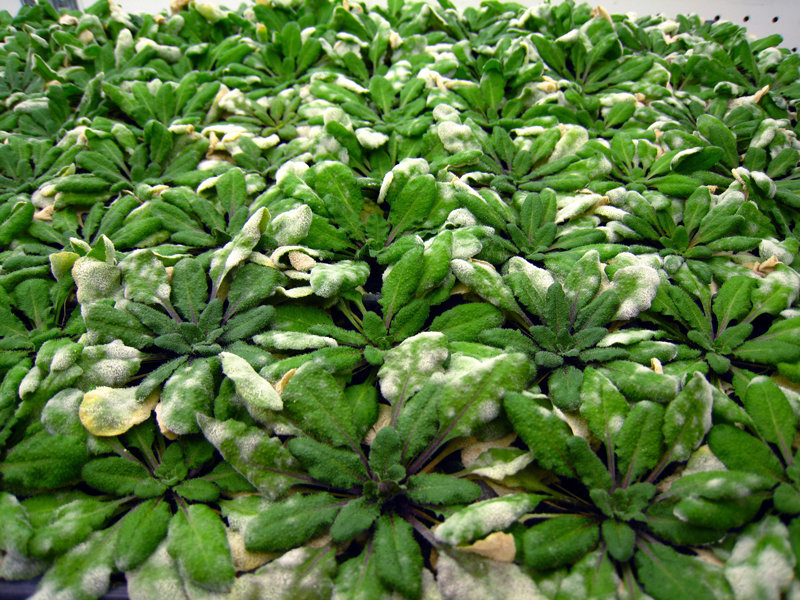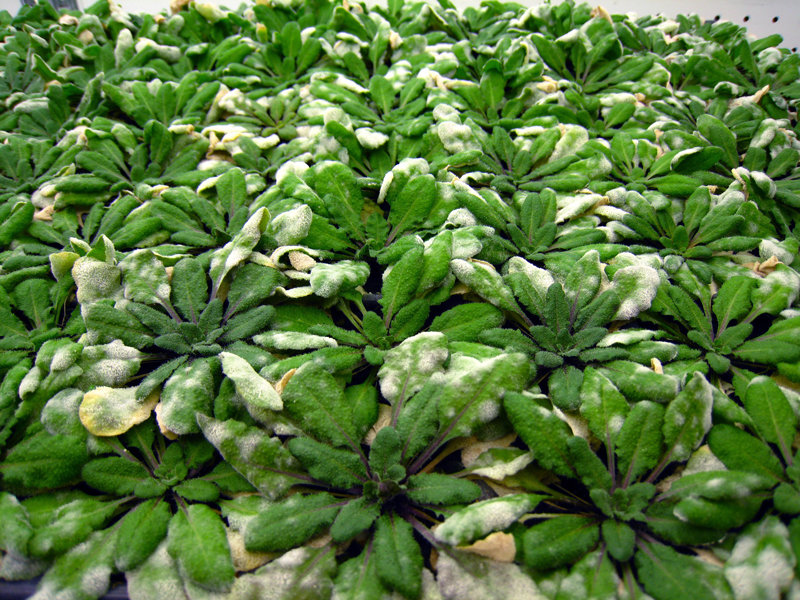Mildew-resistant and infertile
Two proteins involved in powdery mildew infection in plants also play an important role in fertilisation
Mildew infections not only cause unsightly vegetable patches, they can also result in extensive crop failure. Interestingly, the processes involved in infections with this garden pest are similar to those involved in fertilisation. Scientists from the Max Planck Institute for Plant Breeding Research in Cologne and the University of Zurich have identified two proteins in the model plant species Arabidopsis thaliana that are necessary for both fertilisation and infection with powdery mildew. This explains why mildew-resistant plants, in which these genes are mutated, are infertile. (Science, Vol 330, p 968-971)

Pollen tubes and hyphae, the filamentous structures of which fungi are formed, not only look very similar, they also require similar proteins. The two proteins in question, which have just been discovered, are named after the Etruscan fertility goddesses Feronia and Nortia. The scientists discovered that these proteins are both beneficial and harmful to plants. They link the capacity for seed formation with the absence of resistance to mildew infection.
Feronia signals to the pollen tube, which germinates from the pollen, that it has reached its destination and that it is time to release the male gametes. The protein is also formed in the leaves, however, and provides mildew with access to the plant. For the latter to become resistant to the intruder, both the maternal and paternal copies of the feronia gene must be defective. If the plant lacks the feronia protein, however, the pollen tube does not stop growing at the entrance to the embryo sac but continues to penetrate into the female part of the flower and does not trigger the release of sperm cells. As a result, fertilisation does not take place and an embryo does not develop.
The protein Nortia is also involved in fertilisation; however, it does not occur in the leaves. A protein known as MLO, which is closely related to Nortia, is found there instead. MLO makes plants, e.g. barley, in which Ralph Panstruga discovered the MLO gene a few years ago, prone to mildew. However, they only become resistant if both copies of the MLO gene are mutated. Because Arabidopsis has three MLO genes that play a role in susceptibility to mildew, in this plant, six copies must become defunct before it becomes resistant to mildew. Various other genes exist, however, that also cause resistance to fungal infections in plants.
Resistant or fertile
Feronia and Nortia are formed by the helper cells of the embryo sac. They bring about the fusion of the gametes in the ovary. Feronia and MLO in the leaves enable mildew to penetrate into the plant. "This dual function indicates why evolution has not yet succeeded in blocking this point of access to mildew. It would clearly be very difficult to decouple these two functions. Therefore, the alternatives are: resistant and infertile, or vulnerable and fertile," says Ralph Panstruga from the Max Planck Institute for Plant Breeding Research.
Feronia is a receptor that apparently directly influences Nortia. However, the scientists do not yet know how Feronia cooperates with Nortia and MLO. "Our goal is to breed mildew-resistant plants based on Feronia mutants that are also fertile," says Panstruga. This is a very ambitious aim, as evolution appears not to have produced any such mutants up to now. Feronia evidently plays such an important role in the ovary and the leaves that the plant simply cannot manage without it.
